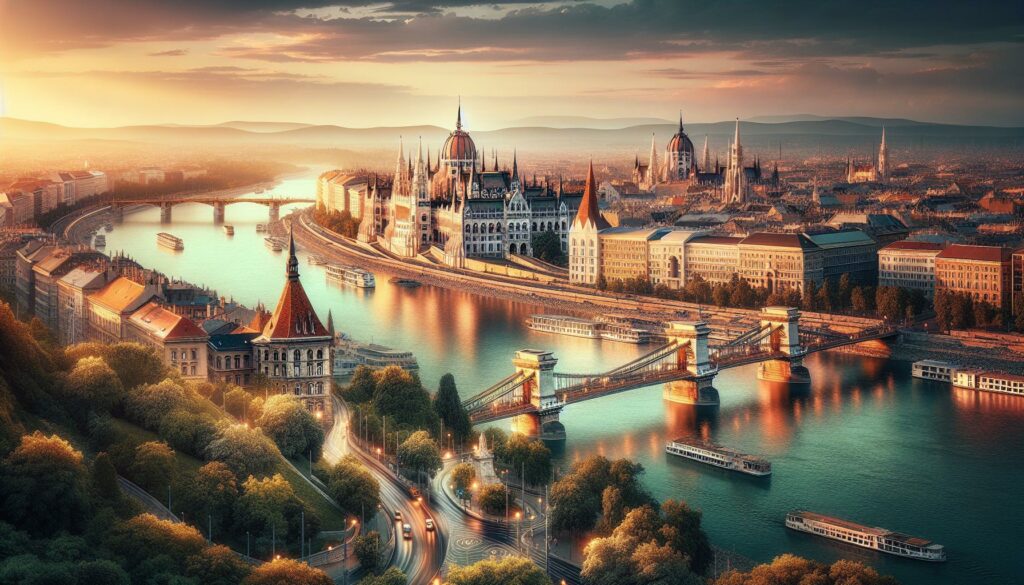When I think of Budapest, I picture a vibrant city steeped in history and culture. Nestled in the heart of Europe, Budapest is the capital of Hungary, and it’s a stunning blend of old-world charm and modern flair. But where exactly is this gem located?
Situated on the banks of the Danube River, Budapest connects the western and eastern parts of the continent. It’s a city that’s easy to fall in love with, offering breathtaking architecture, rich traditions, and a unique atmosphere. If you’re curious about its geographical significance and what makes Budapest a must-visit destination, let’s explore its location and allure together.
Key Takeaways
- Geographical Importance: Budapest is strategically located in Central Hungary along the banks of the Danube River, connecting western and eastern Europe, and serves as a key hub for trade and travel.
- Rich Historical Background: With over 2,000 years of history, Budapest has evolved from a Roman settlement into a vital cultural and political center, marked by significant events like the 1848 Hungarian Revolution and World War II.
- Iconic Landmarks: The city is home to famous landmarks, including Buda Castle, which showcases Hungary’s royal heritage, and the stunning Parliament Building, notable for its unique architectural design.
- Comprehensive Transportation: Budapest features an extensive public transportation network comprising buses, trams, and metro lines, facilitating easy exploration of the city’s vibrant neighborhoods and historic sites.
- Cultural Vibrancy: The city hosts a variety of festivals, such as the Budapest Spring Festival and Sziget Festival, reflecting its diverse cultural tapestry, alongside a rich culinary scene that includes traditional dishes like goulash and langos.
- Accessibility Improvements: Ongoing enhancements in public transport accessibility aim to create a more inclusive environment for all visitors, despite some historical challenges still present at certain stations.
Where is Budapest Hungary Located
Budapest, the capital of Hungary, sits at a crucial cultural and geographical crossroads. Its picturesque setting along the Danube River enhances its status as a prominent European destination.
Geographic Location
Budapest is located in Central Hungary, straddling both banks of the Danube River. This strategic position connects western and eastern Europe, making it an essential hub for trade and travel. It lies approximately 100 miles (160 kilometers) from Vienna, Austria, and about 150 miles (240 kilometers) from Bratislava, Slovakia. The city covers an area of 525 square kilometers (203 square miles), and its population exceeds 1.7 million. Major roadways and railways, including the E60 and E75, pass through Budapest, facilitating access to neighboring countries.
Historical Significance
Budapest boasts a rich history, reflecting influences from various cultures and empires. Founded over 2,000 years ago as a Roman settlement named Aquincum, it later served as the capital of the Kingdom of Hungary. The city witnessed significant events, such as the 1848 Hungarian Revolution and World War II, shaping its modern identity. The unification of Buda, Pest, and Óbuda in 1873 marked a pivotal moment, leading to Budapest’s development into a major cultural and political center in Central Europe. Today, the city’s UNESCO World Heritage Sites, including the Buda Castle and the Danube Banks, testify to its historical importance and architectural beauty.
Major Landmarks in Budapest
Budapest boasts numerous landmarks that reflect its rich history and architectural splendor. Two iconic structures stand out: Buda Castle and the Parliament Building.
Buda Castle
Buda Castle, a UNESCO World Heritage Site, embodies Hungary’s royal heritage. Situated on Castle Hill, it offers panoramic views of the city and the Danube River. The castle complex includes the National Gallery, showcasing Hungarian art, and the Budapest History Museum, which details the city’s past. Visitors can explore the beautiful gardens and enjoy the surrounding medieval architecture, making it a must-see destination in Budapest.
Parliament Building
The Parliament Building, known as Országház, is one of Budapest’s most striking structures. Located along the Danube River, its neo-Gothic design features 88 spires and over 600 rooms. Inside, the grand staircase leads to the stunning Domed Hall, home to the Hungarian Crown Jewels. Guided tours provide insights into Hungary’s legislative process and history, making the Parliament Building a vital stop for anyone visiting Budapest.
Transportation in Budapest
Budapest boasts a comprehensive transportation system that simplifies getting around the city. With various options available, visitors can easily explore the city’s vibrant neighborhoods and historical sites.
Public Transit
Public transit in Budapest includes an extensive network of buses, trams, and metro lines. The Budapest Transport Company (BKK) manages these services, offering reliable and punctual vehicles. The metro system consists of four lines, with Line 1 being the oldest metro line in continental Europe, established in 1896. Buses and trams complement this network, allowing access to all areas of the city. Purchasing a travel card or a single ticket enables seamless transfers between different modes of transport. It’s essential to validate tickets before boarding to avoid fines.
Accessibility
Budapest is making strides in enhancing accessibility within its transportation system. Metro stations have been equipped with elevators and ramps, although some stations still present challenges due to historical layouts. Many buses are wheelchair accessible, ensuring inclusivity for all passengers. Trains at key stations accommodate travelers with mobility needs, and information displays in multiple languages aid navigation. Despite ongoing improvements, visitors requiring assistance should plan routes in advance to ensure a smooth travel experience.
Cultural Significance
Budapest’s cultural significance lies in its rich traditions, vibrant festivals, and unique culinary scene. These elements showcase the city’s history and enhance its status as a cultural hotspot in Europe.
Festivals and Events
Budapest hosts numerous festivals and events throughout the year, reflecting its diverse cultural heritage. Celebrated events include:
- Budapest Spring Festival: This annual festival, held in April, features a variety of performances in music, dance, and theater, showcasing both local and international artists.
- Sziget Festival: A major summer music festival held on Óbuda Island, Sziget attracts thousands of visitors with its lineup of global performers across various genres.
- Budapest Wine Festival: Each September, the festival celebrates Hungary’s viticultural excellence, offering tastings from renowned Hungarian wineries, accompanied by traditional cuisine.
These festivals create a dynamic atmosphere, drawing visitors who wish to experience Budapest’s cultural vibrancy firsthand.
Cuisine and Dining
Budapest’s culinary scene offers a mix of traditional and modern dishes, reflecting the city’s cultural diversity. Key elements include:
- Goulash: A hearty stew made with beef, vegetables, and spices, goulash is a national dish often enjoyed in local restaurants and markets.
- Langos: A popular street food, langos is a deep-fried flatbread topped with sour cream, cheese, or garlic, providing a flavorful snack for on-the-go travelers.
- Cafe Culture: Budapest’s historic cafes, such as Gerbeaud and New York Café, serve as social hubs, where guests can indulge in coffee and pastries while soaking in the atmosphere.
These culinary experiences enrich Budapest’s cultural tapestry, enticing both locals and tourists to explore the city’s flavors.
Budapest’s unique location and rich history make it a fascinating destination. Nestled along the Danube River it serves as a bridge between cultures and histories. I can’t help but appreciate how this city blends the old with the new creating an atmosphere that’s both vibrant and welcoming.
As I explore its stunning architecture and immerse myself in its cultural offerings I find that Budapest truly stands out in Central Europe. Whether you’re drawn to its historical sites or the lively festivals there’s something for everyone in this remarkable city. I encourage you to experience Budapest’s charm firsthand and discover all it has to offer.



